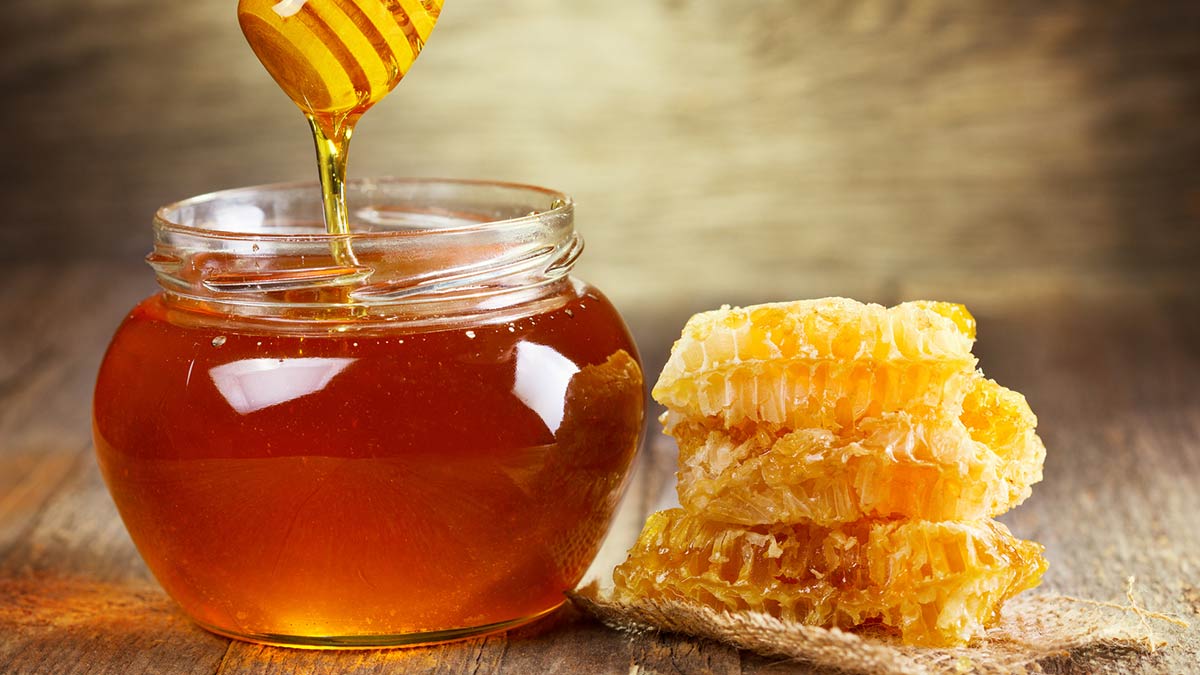The sweetener in question is honey, which not only tastes good but by all accounts is full of health-enhancing compounds. In benefiting from the many properties of this wonderful substance we are, of course, exploiting the hard work of bees who collect and then process the nectar from flowers into the complex and highly variable mixture we call honey.
The exact composition of honey depends on its botanical and geographical origin. Some is designated as being monofloral when bees source it from just a single species, the best-known ones being Manuka and Acacia. Multifloral honey such as Forest honey comes from bees feeding on the nectar of several different plant species. Whatever the source, all honeys are complex mixtures of sugars (80-85 per cent), proteins, enzymes, amino and organic acids, vitamins, minerals and phenolics including flavonoids and phenolic acids dissolved in water. Fructose (38 per cent) is the predominant sugar followed by glucose (31 per cent) along with disaccharides and trisaccharides. According to a 2022 review in the Journal of Ethnopharmacology, the four key bioactive components in honey are hydrogen peroxide, methylglyoxal (MGO), Bee Defensin-1 (the most significant of a number of antimicrobial peptides), and phenolics.
The medical use of honey dates back thousands of years with some sources suggesting its use by the Persians in 6,200BC and it is clear that the ancient Egyptians, Greeks and Romans all used honey, to treat wounds in particular. Nowadays medical grades of honey are sterilised by gamma irradiation in order to kill any Clostridium spores that might be present. Some medical honeys (Revamil®) are produced under controlled greenhouse conditions to ensure reproducible anti-bacterial activity. While anti-bacterial activity is a significant feature of most if not all honeys, other pharmacological effects have been reported such as anti-inflammatory and anti-oxidant properties. According to a 2023 review in Nutrients, beneficial effects have been reported on cardiovascular and metabolic risk factors, in mucositis due to chemo-radiotherapy, cough in children, and in wound healing. In overweight subjects, honey resulted in big reductions in BMI, serum triglycerides, and C-reactive protein levels. Forest, thyme, clover, and tea tree monofloral honeys were effective in reducing the severity of mucositis, weight loss, and dry mouth in cancer patients undergoing chemo and radiotherapy but surprisingly Manuka honey did not produce any improvement.
Another 2023 article in Nutrients looked at the potential use of honey as a neuroprotective agent based on antioxidant activity that it attributed to flavonoids in the honey that presumably came from whatever flowers the bees were obtaining their nectar. Such effects might have relevance in preventing neurodegenerative disease. Reference was also made to the fact that some honeys have shown acetylcholine esterase inhibitory effects in both in vitro and in vivo tests but clinical evidence is confined to a single intervention using a honey-cinnamon combination in one patient. Enough said!
Most attention has focused on antibacterial effects and honey is known to be effective against a wide range of pathogenic bacteria including S. aureus, Pseudomonas aeruginosa and E.coli. A 2022 review in the Journal of Ethnopharmacology reported that various honeys could inhibit biofilm formed by these bacteria as well as Proteus and C.diff. The antibacterial effect is believed to be due to a number of factors including: The low pH (3.2-5.5); the high sugar content that draws water from bacterial cells; and also the presence of hydrogen peroxide. On the other hand, Manuka honey from New Zealand and Australia has little hydrogen peroxide, so MGO is believed to be its main antibacterial component. While most attention has focused on the effects on infected wounds, a systematic review in the Journal of Antimicrobial Chemotherapy in 2020 reported that five RCTs mainly involving Manuka and multifloral honeys showed significant antimicrobial action against eight known periopathogens involved in periodontal disease.
Much of the focus on medical honey has centred on its use in wound care. A 2021 review in Molecules on the role of honey in advanced wound care linked its benefits to a number of effects including its antibacterial activity against common wound-infecting bacteria; its wound-healing ability due to antioxidant and anti-inflammatory activity alongside a capacity to promote re-epithelialisation and angiogenesis essential to the healing of wounds. Equally the osmotic effect of the super-saturated sugar solution helps absorb any oedema around the wound which enhances tissue growth.
Honey-impregnated dressings are more easily removed thus reducing pain and damage to newly grown skin tissue thereby reducing healing time. Many RCTs provide evidence of honey’s effectiveness in different wound types, be it ulcers (leg, varicose, malignant, diabetic or sickle cell), burns, skin grafts, traumatic or surgical wounds, pressure sores, and other non-draining and moderately exuding wounds needing professional supervision. A critical review of honey-based medicinal formulations in Applied Sciences in 2021 also mentions OTC use for minor abrasions, lacerations, minor cuts, scalds, and burns. Most of the approved wound care products are formulated with Manuka honey in the form of creams, pastes, gels, and ointments, although Revamil® source honey has also been approved for clinical use and dressings based on hydrogels and nanofibre scaffolds incorporating honey are under study.
A Cochrane Review of honey as a topical treatment for wounds was updated in 2015. It included 26 trials with 3,011 participants. Three of the trials involved minor acute wounds, 11 involved burns while 10 trials investigated different chronic wounds such as venous leg ulcers, diabetic foot ulcers, with other trials involving infected post-operative wounds and pressure injuries. According to the reviewers, high-quality evidence from two trials with 992 participants showed that honey dressings heal partial thickness burns four to five days more quickly than conventional dressings. Very low-quality evidence from four trials indicated that burns treated with honey heal quicker than those treated with silver sulphadiazine dressings. There was low-quality evidence that honey heals a mixed population of acute and chronic wounds including infected post-operative wounds and pressure ulcers more quickly than either silver sulphadiazine or sugar dressings. The evidence in venous leg ulcers, minor acute wounds, and mixed chronic wounds was unclear.
Honey was more efficacious than silver in terms of fewer days needed for healing, with a more antibacterial effect
A 2016 systematic review and meta-analysis in Contemporary Nurse compared the efficiency of honey compared to silver on burns. The meta-analysis of six RCTs showed that honey was more efficacious than silver in terms of the reduced number of days needed for healing allied to a greater antibacterial effect. Another systematic review comparing honey and povidone-iodine dressings appeared in the Journal of Wound Care in 2021. The meta-analysis of 12 studies involving 1,236 patients found a medium-to-large effect in the reduction of mean healing duration, length of hospital stay, and a VAS score compared to the povidone-iodine that is seen as the standard care but about which there are concerns about the absorption of iodine and subsequent health effects.
All in all, there are many reasons to be grateful to those hard-working bees. While they and other pollinators deserve to be preserved and nourished, I still draw the line at allowing those damned dandelions into the garden!







